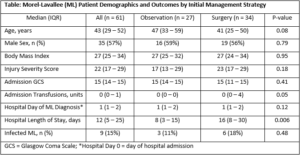Is Initial Management of Morel-Lavallee Lesions Associated with Subsequent Infection?
Author(s):
Shuyan Wei; Christopher Goodenough; Matthew Greives; Jessica Rose; Gabrielle Hatton; Paul Deramo; Charles Wade; Lillian Kao
Background:
Morel-Lavallee Lesions (ML) are closed degloving injuries that disrupt interfascial lymphovasculature between soft tissue and muscle because of shearing forces commonly seen with blunt trauma. Infected ML can require multiple operative debridements and complex reconstruction. No treatment guidelines currently exist, thus it is unknown if initial management strategy has any effect on risk of ML infection.
Hypothesis:
We hypothesized that initial debridement as compared to observation is associated with a reduction in subsequent infection.
Methods:
We conducted a single-center retrospective cohort study of ML in adult trauma patients from 2012 – 2018. ML diagnoses, ML infection status, patient demographics and hospital outcomes were collected from our trauma registry and by chart review. Univariate frequentist analysis was performed.
Results:
A total of 9 (15%) ML infections were found in 61 patients, of whom 34 (56%) underwent initial surgical debridement. Baseline demographics were similar between treatment groups, with the exception of increased admission blood transfusion volume in the initial surgery group (Table). Twenty-three (38%) patients were successfully observed and did not require debridement. ML infection contributed to 1 (11%) death, 3 (33%) intensive care admissions, 3 (33%) hospital readmissions, and significantly greater number of surgical debridements (4 [2-10] vs 2[1-3] debridements, p = 0.05). Initial surgery patients had longer hospital length of stay (LOS [median 16 vs 8 days, p = 0.006]), but there were no significant differences in ML infection rate (18% surgery vs 11% observation, p = 0.48).

Conclusions:
Initial surgical debridement of Morel-Lavallee lesions was not associated with decreased subsequent infection and led to more surgeries and increased hospital LOS in this small study. Given the significant morbidity and increased healthcare burden associated with infected ML, greater awareness is needed to identify these lesions and to monitor them for subsequent infection, regardless of initial management strategy.
